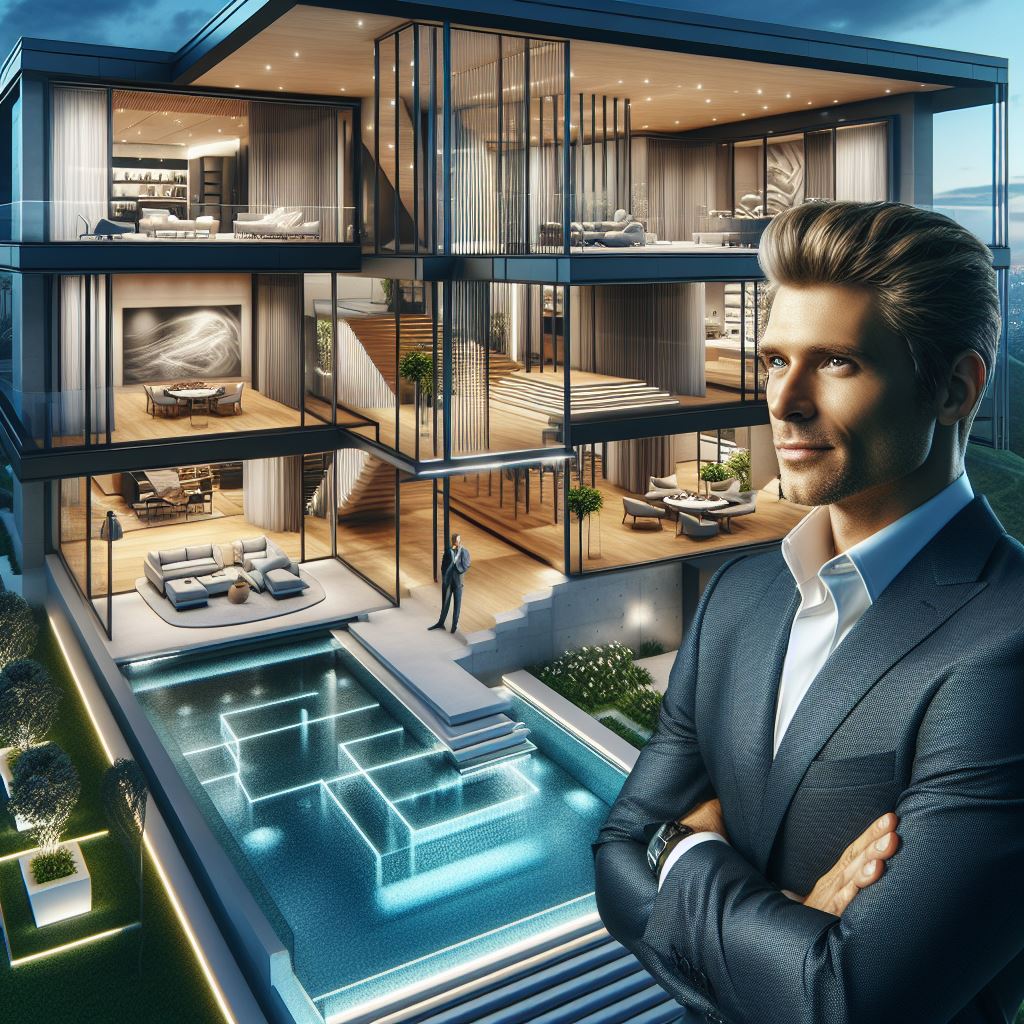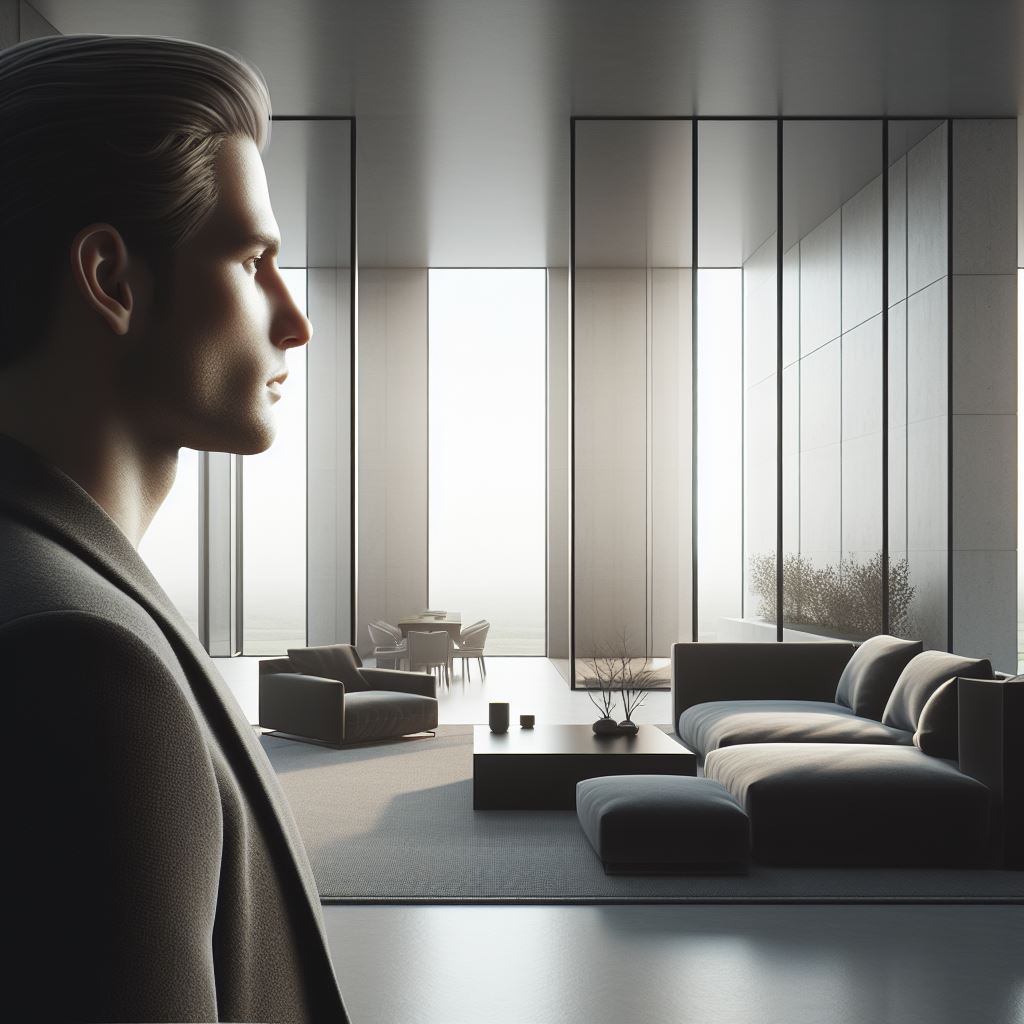Introduction
IModern mansions have evolved beyond opulence, embracing revolutionary designs that redefine luxury living.
In an era where architectural innovation is paramount, these cutting-edge designs serve as a testament to the fusion of aesthetics and functionality.
Revolutionary designs in modern mansions aren’t just about appearances; they represent a shift towards sustainability, efficiency, and a harmonious coexistence with the environment.
Architects and homeowners alike are increasingly recognizing the significance of marrying opulence with eco-consciousness.
This blog post delves into the fascinating realm of revolutionary designs in modern mansions, unraveling the driving forces behind this architectural revolution.
From smart home technologies to sustainable materials, each section unveils a facet of the innovative landscape shaping the homes of tomorrow.
Join us on this journey as we explore the intersection of luxury and forward-thinking design.
Historical Background
The evolution of mansion designs over the years has been heavily influenced by various architectural movements, resulting in modern designs that are truly revolutionary.
Evolution of Mansion Designs
Mansion designs have come a long way, from the opulent and grand styles of the past to the sleek and minimalist designs of today.
During the Renaissance period, mansions were characterized by their symmetrical layouts, ornate decorations, and expansive gardens.
In the Baroque era, mansions became even grander, with elaborate facades, grand staircases, and gilded interiors.
The Victorian era saw a shift towards more eclectic designs, with mansions featuring a mix of architectural styles such as Gothic, Romanesque, and Queen Anne.
By the early 20th century, the Arts and Crafts movement brought about a return to simpler designs, focusing on craftsmanship and natural materials.
In the mid-20th century, modernist architects like Frank Lloyd Wright revolutionized mansion designs with open floor plans, large windows, and an integration with nature.
Influence of Architectural Movements
Architectural movements have played a significant role in shaping modern mansion designs.
The Bauhaus movement, with its emphasis on functionality and simplicity, inspired minimalist designs that are still popular today.
The International Style, characterized by clean lines and geometric shapes, influenced the modernist designs of mansions, emphasizing the use of steel, glass, and concrete.
The Postmodern movement introduced a playful and eclectic approach to mansion designs, combining elements from different architectural styles.
Famous Mansions with Innovative Designs
Several famous mansions have pushed the boundaries of design, showcasing innovative and cutting-edge architectural concepts.
The Fallingwater house, designed by Frank Lloyd Wright, is a prime example of modern architecture.
The house seamlessly integrates with its natural surroundings, featuring cantilevered balconies and a stunning waterfall.
The Glass House, designed by Philip Johnson, is a transparent structure that blurs the line between interior and exterior spaces, offering a unique living experience.
The Villa Savoye, designed by Le Corbusier, embodies the principles of the International Style, with its sleek white facade, ribbon windows, and roof garden.
Throughout history, mansion designs have evolved and been influenced by architectural movements, resulting in the revolutionary designs we see today.
From the grandeur of the Renaissance to the simplicity of modernist designs, mansions continue to push the boundaries of what is possible in architectural design.
Read: Luxury Living: The Rise of Smart Kitchens
Key Elements of Revolutionary Designs
Revolutionary designs in modern mansions are characterized by several key elements that set them apart from traditional architectural styles.
These elements incorporate sustainable and eco-friendly features, smart home technology, maximize space utilization and functionality, creatively use materials and textures, and emphasize unique and bold architectural shapes.
Integration of Sustainable and Eco-Friendly Features
One of the primary focuses of revolutionary designs in modern mansions is the integration of sustainable and eco-friendly features.
These features aim to minimize the environmental impact of the mansion while maximizing energy efficiency and reducing carbon footprints.
Incorporating solar panels, rainwater harvesting systems, and energy-efficient appliances are common examples of sustainable practices.
Incorporation of Smart Home Technology
Another crucial element in revolutionary designs is the seamless integration of smart home technology.
This technology allows homeowners to control various aspects of their mansion remotely, providing convenience, comfort, and enhanced security.
Smart lighting systems, voice-controlled assistants, and automated climate control systems are becoming increasingly popular in modern mansions.
Maximizing Space Utilization and Functionality
Revolutionary designs in modern mansions prioritize maximizing space utilization and functionality.
Clever interior layouts and innovative storage solutions ensure every inch of the mansion is put to good use.
Built-in cabinets, hidden compartments, and multi-functional furniture help optimize space and create a clutter-free environment.
Creative Use of Materials and Textures
Incorporating diverse materials and textures adds visual interest and uniqueness to modern mansions.
Revolutionary designs often utilize a combination of glass, metal, wood, and concrete to create a striking contrast.
Textured walls, patterned tiles, and unique flooring materials further enhance the visual appeal of these mansions.
Emphasis on Unique and Bold Architectural Shapes
Revolutionary designs in modern mansions prioritize unique and bold architectural shapes.
These designs challenge traditional norms and explore unconventional forms, resulting in visually captivating structures.
Cantilevered sections, geometric shapes, and asymmetrical facades are some examples of architectural elements that add character and distinctiveness to these mansions.
In essence, revolutionary designs in modern mansions embrace key elements that set them apart from traditional architectural styles.
The integration of sustainable and eco-friendly features, incorporation of smart home technology, maximizing space utilization and functionality, creative use of materials and textures, and an emphasis on unique and bold architectural shapes collectively contribute to the innovative and captivating nature of these designs.
As modern architecture continues to evolve, these key elements will continue to shape and redefine the concept of luxury living in mansions.
Read: Futuristic Homes: Where Luxury Meets Tech
Case Studies of Groundbreaking Modern Mansions
Fallingwater (Mill Run, Pennsylvania)
Designed by Frank Lloyd Wright in 1935, Fallingwater is a masterpiece of organic architecture, cantilevering dramatically over a waterfall.
Its integration with the natural surroundings and seamless blend of interior and exterior spaces continue to inspire architects and homeowners alike.
Impact of the design on the overall experience and value
Fallingwater’s unique design creates an unparalleled experience for its occupants, who are constantly connected to the natural beauty that surrounds the house.
The cantilevered structure allows for breathtaking views of the waterfall, enhancing the overall sense of tranquility and serenity.
This design also adds significant value to the property, as it stands as an iconic example of architectural innovation.
Architectural and interior design accolades received
Due to its groundbreaking design, Fallingwater has received numerous accolades and recognition in the architectural and design community.
It has been designated as a National Historic Landmark and is listed on the UNESCO World Heritage List.
Additionally, it has received awards for its innovation and contribution to the field of architecture.
The Stahl House (Los Angeles, California)
Perched on the hillside above Los Angeles, the Stahl House by Pierre Koenig (1959) is a stunning example of mid-century modern architecture.
Its glass walls offer panoramic views, while its open floor plan and use of steel beams create a sense of weightlessness and connection to the landscape.
Notable features that set it apart from traditional mansions
The Stahl House stands out from traditional mansions due to its unique architectural elements and design principles.
The extensive use of glass walls blurs the boundaries between indoor and outdoor spaces, creating a seamless transition between the interior and the breathtaking views outside.
This transparency and connection to the landscape set the house apart and create a sense of unity with its surroundings.
Impact on energy efficiency and sustainability
The Stahl House’s design incorporates many sustainable features that prioritize energy efficiency.
The use of steel beams and glass walls allows for natural ventilation and ample natural light, reducing the need for artificial cooling and lighting.
Additionally, the integration of the house with the surrounding landscape helps to minimize its ecological footprint and preserve the natural beauty of the site.
Through case studies of groundbreaking modern mansions like Fallingwater and the Stahl House, it is evident that revolutionary designs have a significant impact on the overall experience, value, and sustainability of these homes.
These architectural feats continue to inspire and shape the future of design, offering homeowners a unique and extraordinary living experience.
Read: Top Smart Tech Must-Haves in Luxury Homes

Architects and Designers Shaping the Future
In the world of modern mansions, there are several architects and designers who have made a significant impact.
Their groundbreaking works and innovative designs have reshaped the industry and continue to inspire the next generation.
Here, we will explore some renowned architects and designers who are shaping the future of mansion design.
Renowned architects and designers
Frank Gehry
Frank Gehry is one of the most influential architects of our time.
Known for his bold and unconventional designs, Gehry has pushed the boundaries of traditional mansion architecture.
His unique style combines sharp angles, curves, and unexpected materials.
His masterpiece, the Guggenheim Museum in Bilbao, Spain, showcases his avant-garde approach.
Zaha Hadid
Zaha Hadid, the first woman to receive the prestigious Pritzker Architecture Prize, has created some of the most iconic mansion designs in recent years.
Her fluid and organic forms challenge the notions of symmetry and conventional structures.
The Heydar Aliyev Center in Baku, Azerbaijan, is a prime example of her futuristic style.
Bjarke Ingels
Bjarke Ingels is a Danish architect known for his innovative and sustainable designs.
His firm, BIG, has gained international recognition for its unique architectural concepts. Ingels combines elements of nature, technology, and urban planning in his projects.
The Mountain Dwellings in Copenhagen is a pioneering development that seamlessly bridges architecture and nature.
Rem Koolhaas
Rem Koolhaas, the founder of OMA, is a visionary architect who has extensively explored the relationship between architecture, society, and urbanism.
His works challenge conventional ideas about space and function.
The CCTV Headquarters in Beijing, China, represents his experimental approach to design and reflects his deep understanding of urban dynamics.
Jean Nouvel
Jean Nouvel is a French architect renowned for his contextual designs that respond to their surroundings.
His iconic projects exhibit a blend of innovation and cultural sensitivity.
The Louvre Abu Dhabi is a stunning example of his ability to create a modern masterpiece while respecting the local heritage and environment.
How their designs have influenced the industry as a whole
These architects and designers have revolutionized the mansion sector by pushing boundaries, experimenting with materials and forms, and creating structures that are not only aesthetically pleasing but also sustainable and functional.
Their designs have had a profound influence on the industry as a whole.
By challenging traditional norms and embracing new ideas, these architects and designers have inspired a wave of innovation in mansion design.
Their works serve as a catalyst for change, encouraging other professionals to think differently and experiment with their own designs.
Furthermore, the impact of these architects and designers can be seen in the wider construction industry.
Their innovative use of materials, technology, and sustainable practices has inspired others to adopt similar approaches.
As a result, we are witnessing a transformation in the way mansions are built, with a greater focus on eco-friendly solutions and integrating with the natural environment.
In fact, architects like Frank Gehry, Zaha Hadid, Bjarke Ingels, Rem Koolhaas, and Jean Nouvel are shaping the future of modern mansions.
Through their groundbreaking works and visionary designs, they have left an indelible mark on the industry.
As the next generation of architects and designers strive to make their mark, we can expect to see even more revolutionary designs emerge in the world of modern mansions.
Read: Eco-Friendly Luxury: Green Architecture Gems
Future Trends in Modern Mansion Designs
In this section, we will explore the predictions for upcoming architectural and design trends in modern mansion designs.
With the rapid advancements in technology and the evolving needs of homeowners, the future of mansion design is bound to be revolutionary.
Predictions for Upcoming Architectural and Design Trends
Incorporation of sustainable and energy-efficient practices will become a standard in modern mansion designs.
Mansions will feature open floor plans with seamless indoor-outdoor connections, blurring the boundaries between nature and luxury living.
Smart homes will dominate the modern mansion landscape, with integrated technologies enhancing comfort, security, and convenience.
Minimalism will continue to be a popular choice, with clean lines and clutter-free spaces creating a sense of calm and sophistication.
Resilient design will gain importance to withstand natural disasters and ensure the safety of mansion occupants.
Integration of Artificial Intelligence and Automation
Artificial intelligence (AI) and automation will revolutionize modern mansion designs, offering unparalleled convenience and efficiency.
Voice-controlled systems will become prevalent, allowing homeowners to control various aspects of their mansions through simple commands.
AI-powered personal assistants will assist with tasks, manage energy consumption, and adapt to the occupants’ preferences over time.
Automated systems will monitor and adjust lighting, temperature, and security, providing a luxurious and effortless living experience.
Exploration of Unique Building Materials and Technologies
The future of modern mansion designs will witness the use of innovative building materials and technologies, pushing the boundaries of what is possible.
Advancements in 3D printing will allow for the creation of intricate and customized architectural elements, reducing construction time and costs.
Integration of sustainable and eco-friendly materials, such as recycled glass, salvaged wood, and solar panels, will be paramount.
Smart glass technology will gain popularity, offering privacy, energy efficiency, and the ability to alter transparency levels.
Importance of Adaptive Reuse and Sustainable Practices
With the growing emphasis on sustainability, adaptive reuse and sustainable practices will play a vital role in modern mansion designs.
Renovating historic mansions and repurposing them for modern living will be a popular trend, preserving architectural heritage.
Net-zero energy designs will be implemented, significantly reducing the environmental impact of mansions through efficient energy systems.
Integration of green spaces, vertical gardens, and renewable energy sources will enhance the harmony between the mansion and its natural surroundings.
Water conservation measures, such as rainwater harvesting and efficient irrigation systems, will be integrated into modern mansion designs.
The future trends in modern mansion designs promise a harmonious blend of luxury, sustainability, and technological advancements.
As homeowners seek unique and innovative living spaces, architects and designers will continue to push the boundaries of creativity and functionality to create the mansions of tomorrow.
Conclusion
Throughout this post, we have explored the revolutionary designs found in modern mansions.
These innovative architectures have redefined luxury living and have attracted the attention of homeowners and architects alike.
By incorporating cutting-edge technologies, eco-friendly materials, and functional layouts, modern mansions offer a unique blend of sophistication and practicality.
The seamless integration of indoor and outdoor spaces, along with the incorporation of sustainable practices, has transformed mansions into sustainable and efficient homes.
These evolving designs are essential in meeting the changing lifestyles and needs of homeowners.
As society progresses, people are seeking spaces that can adapt to their dynamic lives.
They desire personalized and customizable spaces that reflect their individuality and offer a sense of harmony with the environment.
We encourage our readers to explore and appreciate these innovative designs.
Take inspiration from the sleek lines, vast windows, and open floor plans that redefine luxury architecture.
Witness how these designs successfully blend aesthetics with functionality and sustainability.
What is your opinion? Have you come across any impressive modern mansions or unique designs?
We would love to hear your thoughts and experiences in the comments section below.
Share your insights, inspirations, and any other revolutionary designs that have caught your attention!



